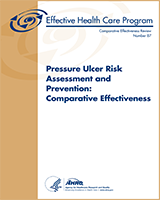| Braden | 6 subscales: mobility, activity, sensory perception, skin moisture, nutrition state and friction/shear | General | 6–23; lower scores indicate higher pressure ulcer risk |
| Cubbin and Jackson | 15 subscales: age, weight, medical history, skin condition, mental state, mobility, nutrition, respiration, incontinence, hygiene, hemodynamic state, oxygen requirements; use of blood products, surgery within 24 hours, hypothermia | Intensive care unit | 9–48; lower scores indicate higher pressure ulcer risk |
| Norton | 5 subscales: physical condition, mental state, activity, mobility, incontinence | General | 5–20; lower scores indicate higher pressure ulcer risk |
| Waterlow | 11 subscales: build/weight for height, skin condition, sex and age, continence, mobility, appetite, medication, other risk factors (tissue malnutrition, neurological deficit, major surgery or trauma) | General | 1–64; higher scores indicate higher pressure ulcer risk |
